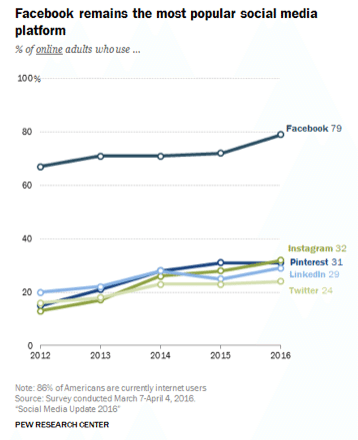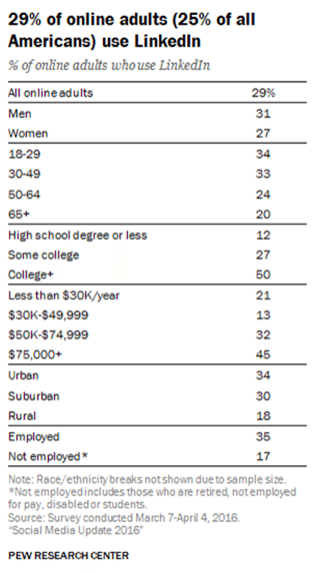Who Should Use LinkedIn Ad Campaigns?

While Facebook leads the social media world by a landslide, LinkedIn has its own unique benefits which carve out a place for it in the market.

The platform focuses on business professionals, creating an audience that Facebook and other popular platforms can’t provide. If you’re wondering if you should be using LinkedIn to create a presence, find leads, and potentially further your reach with LinkedIn ad campaigns, here’s what you need to know.
LinkedIn Demographics
Let’s take a look at the demographics of LinkedIn users so you can understand the user base a bit better. In 2015, 25% of the adults that were present online used LinkedIn. In 2016, that percentage jumped to 29%. Not much of a change, but an increase nonetheless, which means the platform is growing.
When it comes to income, households that earn $75,000 or more per year make up 45% of the LinkedIn population. Those earning $30,000 or less only account for 21%. As for education, 50% of the adults that are online and who have earned some form of a college degree have a profile on LinkedIn. Half! That is a significant difference from the 27% that have some college education but never earned a degree. Those with a high school diploma or less only represent a much smaller 12% of the LinkedIn population.

So what target audience fits these demographics?
You’re looking at a concentrated pool of well-educated business professionals. Not only that but they also come to LinkedIn for business purposes. This creates a great opportunity for networking and finding potential leads. If your audience includes business professionals LinkedIn is likely the right choice, but let take a closer look at the features on the platform.
LinkedIn Features
To find out if LinkedIn is going to suit your business needs, consider the features it offers.
For starters, you have your profile, like on any other social media platform. However, this one focuses on your professional information. You will include your professional headline, current job, past jobs, and the industry you work in, all of which display next to your name.
Additionally, you will summarize yourself professionally and list all of the experience you have. The layout is very similar to a resume, and can actually function as one. You then can list your education, skills, volunteer experience, publications, and much more.
Once you’re past the profile building, there are many ways to network. You can:
- Seek out other professionals using a wide range of search filter options
- Gain endorsements on your skills and reviews from past colleagues
- Browse through your newsfeed to like and comment on posts
- Add people based on existing contact lists you have
- Send direct messages
- Join groups and connect with other based on interests
- Write and publish articles
- Use the jobs section where you can post an open position or find applicants
- Run ad campaigns to reach your desired audience
The opportunity to connect with other professionals for various purposes is the key benefit here. Whether you want to find customers, influencers, employees, or peers, you can do so easily.
Great for Targeting a Professional Audience
If your target audience includes business professionals, and you’re not yet convinced LinkedIn is right for you, take a look at these stats:
- Consider that 49% of the top decision makers from a plethora of different businesses and industries use the website to aid them in their related corporate ventures.
- In all, one out of every three authorities uses LinkedIn to help them make contacts.
- In a report done by the Social Media Marketing Industry in 2015, Facebook dropped out of the number one spot for this style of online communication and was replaced by LinkedIn for the B2B industry.
- 41% of the B2B organizations that were polled about their preferred social networking site, named LinkedIn at the very top of their list.
- Regalix performed a poll of several B2B companies and asked them what they were using to show off any of their new offerings, including various goods and services. Again the number one spot for this category was LinkedIn, with 81% of the launches being done on the platform. In comparison, only 71% launched their product on Twitter, and 54% on Facebook.
What you can take from these findings is, if you are in B2B sales, you stand to benefit from using LinkedIn.
How Using LinkedIn Benefits B2B Companies
Now that we have identified that B2B companies are the primary businesses who should be using LinkedIn for advertising, let’s look at some of the benefits.
First, by signing up, you are making your online existence known. The more people in your target audience that know about you, the more chances you have for sales.
How do you turn connections into sales?
Well, you will have to nurture your leads through the buying cycle just like anywhere else. For starters, you can build brand awareness and authority in your industry by regularly sharing relevant and helpful information in your posts. It is a good idea to engage with other people’s posts by commenting and providing your input in conversations. You can also publish articles right on the platform which help establish thought-leadership. To further extend your reach, ad campaigns can be utilized. Even if your connections don’t have a need or aren’t aware of it yet, you will be in their peripheral vision when a need does arise that you can solve.
Once a need is identified, you can help leads in the consideration stage who want to learn more about your products and services. By sharing content about your offering periodically, leads will be able to evaluate their options in order to move closer to making a decision. Ad campaigns can also be used to promote webinars, whitepapers, free trials, or other strategic content.
When a prospect is ready to validate your business, social proof on your profile can help to win them over. It’s wise to build a collection of positive reviews, endorsements, connections, and engagement. Then, you can directly engage with consumers, answer inquiries, and close sales through the direct messaging feature.
LinkedIn and B2B Just Go Together
In conclusion, if you are wondering if LinkedIn is right for you, simply ask yourself if your audience includes business professionals. If the answer is yes, you should absolutely be on LinkedIn. It is a great place to find successful, educated professionals that are looking for solutions. There is also great potential to improve your business by becoming an industry leader, making the right connections, and becoming personally engaged with those that are interested in your offerings.
Are you part of a B2B company that wants to start advertising on LinkedIn? Learn more about creating ad campaigns and optimizing them in these articles.
